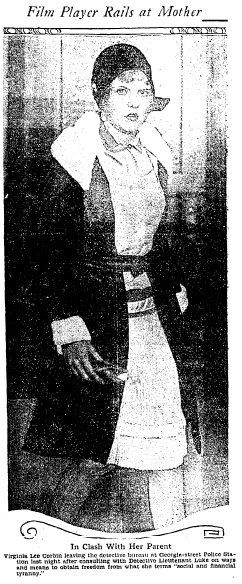
November 6, 1927
Hollywood
Mrs. L.A. Corbin, 45, was rushed to the police receiving hospital today after she telephoned her neighbor and declared, “I have just swallowed enough poison to kill ten men!” While doctors labored to save Mrs. Corbin’s life, her 17-year-old daughter, former child star and current film ingénue Virginia Lee Corbin, told police she was ready to sign an insanity complaint against her mother. Mrs. Corbin had “taken all the money I’ve made in pictures,” Virginia Lee told detectives. “Mother wanted more money tonight and I wouldn’t give it to her; besides, she wouldn’t let me go out. I guess that’s the reason for all this. Let’s get it over with. If she acted this way before, she’ll do it again.” An ambulance took Mrs. Corbin to General Hospital’s psych ward, while a Times reporter snapped a photo of disgruntled looking Virginia Lee leaving the Georgia Street Police Station.
Two days later, Virginia withdrew her complaint. “She didn’t know what she was signing when she signed the complaint,” explained her adopted sister, Ruth Miehle. “Police Mystified by Action” read the Times sub-head that day; detectives noted that that Virginia had questioned them at length about the ramifications of signing the complaint, and went so far as to ask them to sign the document as complaining witnesses. Virginia herself was conspicuously unavailable for comment, so Ruth explained further: “There is absolutely nothing to the statements that Virginia is angry at mother over money matters.” Virginia’s assertions to the contrary, Ruth reported, were “misstatements by the police. But the police were equally certain that the statements had been made,” reported the Times. At any rate, Mrs. Corbin was moved to the relative comfort of the Rosemeade Sanatorium.

On November 9, the Times ran a photo of a smiling Virginia and Ruth on either side of their wheelchair-bound mother. “The family life of Virginia Lee Corbin once more is announced as harmonious,” wrote columnist Harry Carr shortly thereafter. “The loving daughters have not only released their mother from danger of going to a cell for the insane, but they have been publicly photographed chucking her under chin. I just don’t see the connection, but I have a feeling that chucking one’s relative’s under the chin is a public indication that you didn’t mean what you said-or something. At any rate, during the long winter evenings that family have much to talk about.” Or not-for despite the apparent reconciliation, Virginia petitioned the court for and was a granted a guardian. She also established a trust fund as a “first step toward recuperating asserted financial losses” due to “maternal extravagances.”
Mrs. Corbin recovered from her suicide attempt. The Corbin family contained to display a flair for drama. In 1929, the Times reported that Virginia was missing, possibly kidnapped, before she showed up on a train bound for New York City. Five years later, Mrs. Corbin instigated a search for Virginia and her family after hearing of “reports” in the British press that they were stranded in Belgium. Again, they were safe in New York.
Virginia Lee Corbin continued to act in smaller and smaller roles. “When the talkies began to displace the silent films, I decided an English accent would be a great help,” she told the press in 1930. Nevertheless, by 1936 the Times included her in an article devoted to the “Many Forgotten Names” of the previous decade. Her first marriage ended in divorce when her broker husband accused her of “habitual drunkenness.” Whether or not it was true, Corbin lost custody of both her sons. She died in 1942 of either heart disease or tuberculosis. She was only 32 years old.
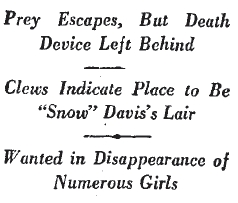 The headline read, "TORTURE DEN AND POISON PEN OF SUSPECTED DOPE SLAYER BELIEVED FOUND," and the story itself contained six missing girls, a basement torture chamber, and a "trick" pencil that could turn into hypodermic needle, chock full of poison, with the flick of a finger.
The headline read, "TORTURE DEN AND POISON PEN OF SUSPECTED DOPE SLAYER BELIEVED FOUND," and the story itself contained six missing girls, a basement torture chamber, and a "trick" pencil that could turn into hypodermic needle, chock full of poison, with the flick of a finger. The headline read, "TORTURE DEN AND POISON PEN OF SUSPECTED DOPE SLAYER BELIEVED FOUND," and the story itself contained six missing girls, a basement torture chamber, and a "trick" pencil that could turn into hypodermic needle, chock full of poison, with the flick of a finger.
The headline read, "TORTURE DEN AND POISON PEN OF SUSPECTED DOPE SLAYER BELIEVED FOUND," and the story itself contained six missing girls, a basement torture chamber, and a "trick" pencil that could turn into hypodermic needle, chock full of poison, with the flick of a finger.

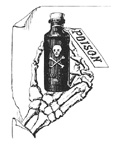

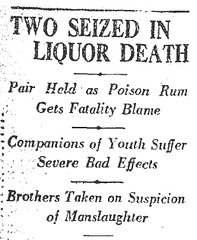


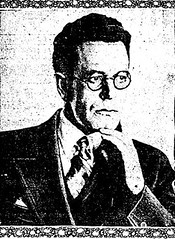 If there is an explanation for the obvious overkill in the murder of Albert Snyder, it must be that Ruth’s previous attempts to snuff out the life of her husband (twice by asphyxiation and once by poison) had failed – and she wasn’t about to give up. Ruth had persuaded her husband to take out a double indemnity policy, which would pay her in the event of his accidental death. It was the lure of the $97,000 worth of life insurance that compelled her to continue with her diabolical schemes until she succeeded.
If there is an explanation for the obvious overkill in the murder of Albert Snyder, it must be that Ruth’s previous attempts to snuff out the life of her husband (twice by asphyxiation and once by poison) had failed – and she wasn’t about to give up. Ruth had persuaded her husband to take out a double indemnity policy, which would pay her in the event of his accidental death. It was the lure of the $97,000 worth of life insurance that compelled her to continue with her diabolical schemes until she succeeded. 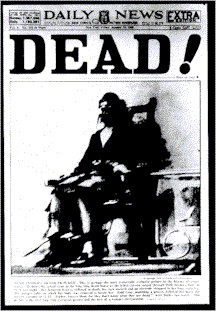

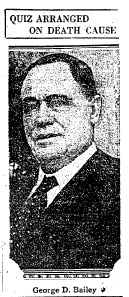

 Over 100 Pasadena residents are clutching their guts today, the victims of a recent outbreak of food poisoning. Those affected had all eaten a batch of tainted French vanilla ice cream sold by a local catering company. At first, the toxins were suspected to have come from the copper mixing vats used by the unnamed company; however, after questioning some of its employees, City Bacteriologist C.W. Arthur and City Chemist Frank Marks (how ’bout those job titles!) uncovered the true culprit.
Over 100 Pasadena residents are clutching their guts today, the victims of a recent outbreak of food poisoning. Those affected had all eaten a batch of tainted French vanilla ice cream sold by a local catering company. At first, the toxins were suspected to have come from the copper mixing vats used by the unnamed company; however, after questioning some of its employees, City Bacteriologist C.W. Arthur and City Chemist Frank Marks (how ’bout those job titles!) uncovered the true culprit.






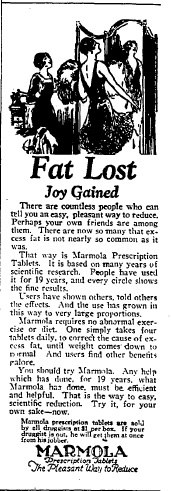
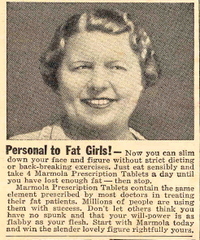 A young woman from Chicago came forward with a horror story that left courtroom watchers in tears. She told the judge that she had purchased Marmola because she was tired of her weight being the subject of cruel taunts by her classmates. Her excess pounds began to melt away, but she had also developed some nasty side effects. She hadn’t known that she was taking desiccated thyroid in toxic amounts. By the end of seven months she was vomiting regularly and her weight would eventually plummet to a cadaverous 50 pounds! At the time of the trial she was deathly ill with persistent symptoms of
A young woman from Chicago came forward with a horror story that left courtroom watchers in tears. She told the judge that she had purchased Marmola because she was tired of her weight being the subject of cruel taunts by her classmates. Her excess pounds began to melt away, but she had also developed some nasty side effects. She hadn’t known that she was taking desiccated thyroid in toxic amounts. By the end of seven months she was vomiting regularly and her weight would eventually plummet to a cadaverous 50 pounds! At the time of the trial she was deathly ill with persistent symptoms of